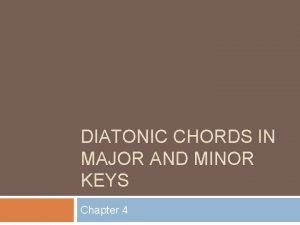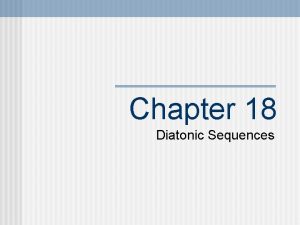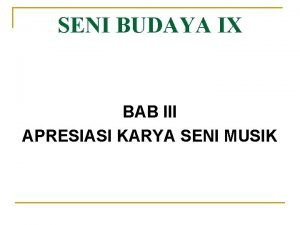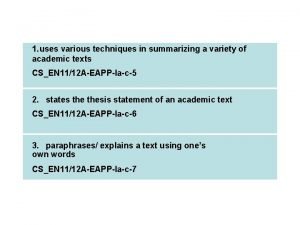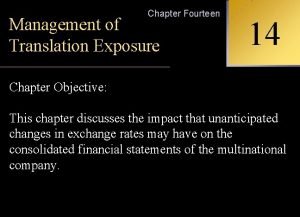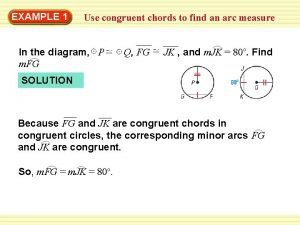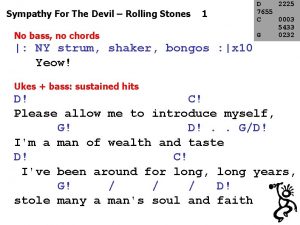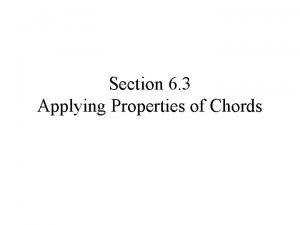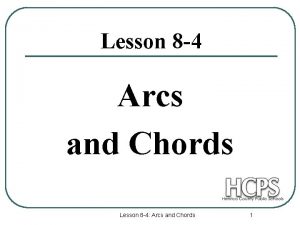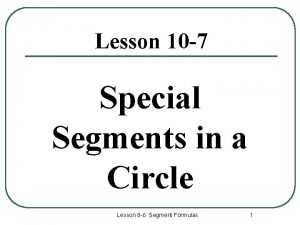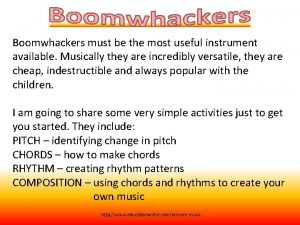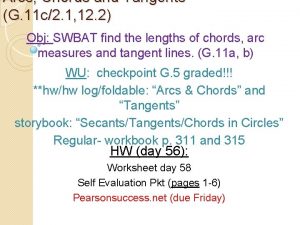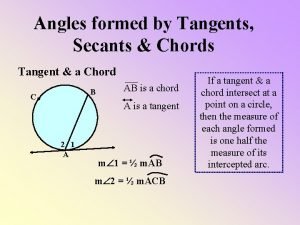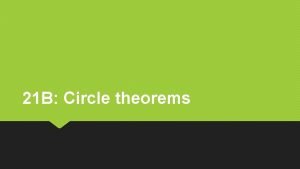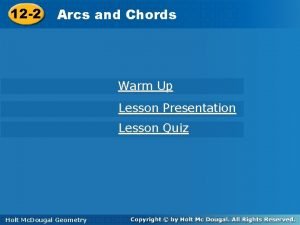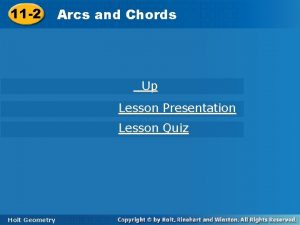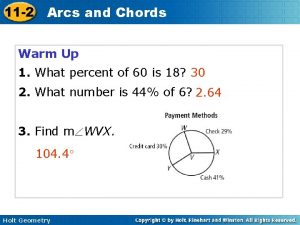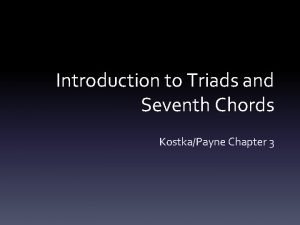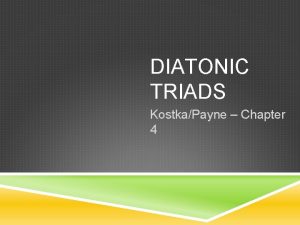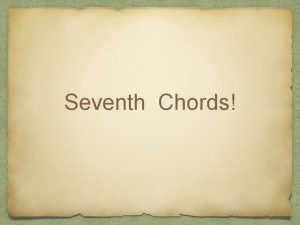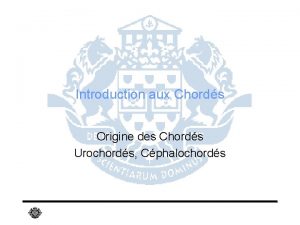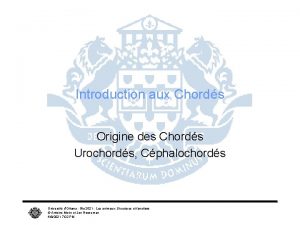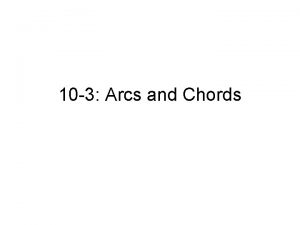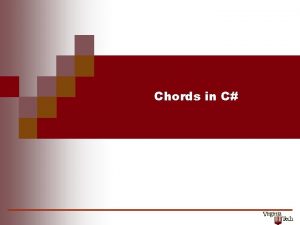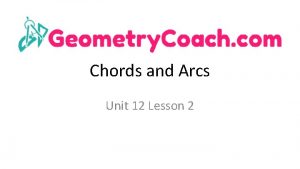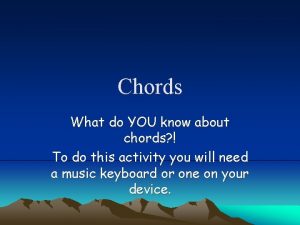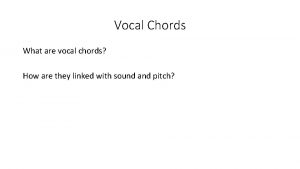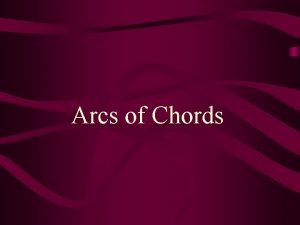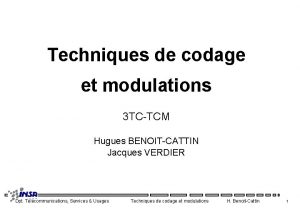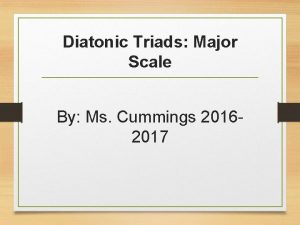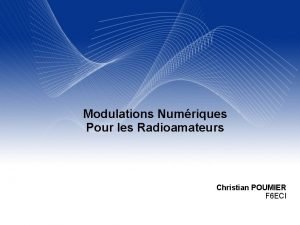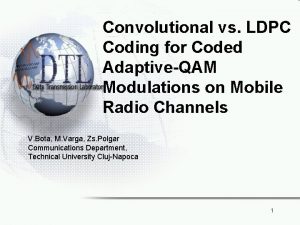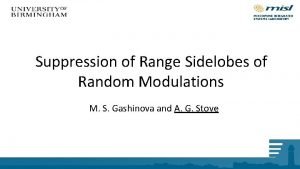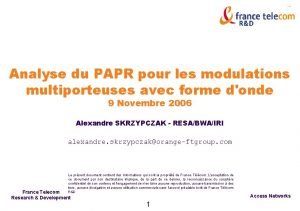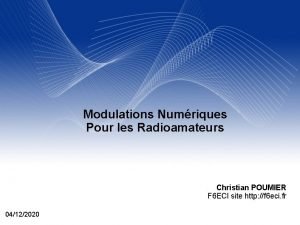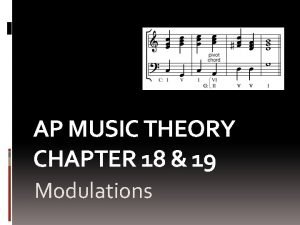MODULATIONS DIATONIC COMMON CHORDS ARE OTHER VARIOUS TECHNIQUES


























- Slides: 26

MODULATIONS DIATONIC COMMON CHORDS ARE OTHER VARIOUS TECHNIQUES TONAL HARMONY BOOK, P. 303

WHAT IS A MODULATION? • Almost all music compositions start and end in the same key signature • Sometimes there is a MODE change (minor to major, or vise versa) • A piece that begins in C minor and ends in C major is still in C. (Keynote is the same) • If a piece of multi-movement music (ex. symphonies) are each in a different key (Movement 1 in C major, Movement 2 in F major, Movement 3 in a minor, Movement 4 in C major) is indicative of a change in key. • This means that each piece of the unit is in it’s own key. • A MODULATION is a term used when a movement of a piece changes key within the piece. • Change in the key note. • Ultimately, even when there’s a modulation, you still want the piece to end with the same keynote that it starts.

MODULATION VS. TONICIZATION • To modulate and to tonicize are two different things, although they may be hard to decipher • REMEMBER: Tonicization refers to secondary functions – when a chord is taken from another key (“borrowed”). • One person may listen to an excerpt of music and consider the passage to be tonicizing, while someone else may hear it as a clear modulation. • The clearest way to detect the difference is the amount of time. (How long does it appear to be in a different key? ) • Remember that a passage must have a cadence in the new key in order for it to be considered within the key. LET’S LISTEN TO THIS BEETHOVEN EXERPT. DO YOU HEAR IT AS A MODULATION OR TONICIZATION IN C MAJOR?

KEY RELATIONSHIPS • Two keys that sound the same but are spelled differently are called enharmonically equivalent keys. • Ex. C# Major and Db Major • If a composer changes the key from C# to Db, a modulation has not occurred because they keynote has not changed. • If a major key and a minor key have the same tonic pitch, they are called parallel keys. • Ex. C major and c minor, B-flat major and b-flat minor • Because the tonic pitch has not changed, we do not consider this a modulation, but rather a change of mode. • If a major and minor key share the same key signature, we refer to that as relative keys. • Ex. C major and a minor, F major and d minor

CLOSELY RELATED KEYS • Most modulations in music occur between closely related keys. • Difference of no more than one key signature in either direction • This applies to both major and minor key signature • Almost all keys have 5 closely related keys • TRY THIS: If the key is C major, what are its closely related keys? • A minor (It’s relative minor) • F major (one key signature down) • D minor (that key’s minor) • G major (one key signature up) • E minor (its minor)

CLOSELY RELATED KEYS • TRY ANOTHER ONE: What are the closely related keys to E-flat Major? • C minor (its minor) • B-flat major (one key signature down) • G minor (its minor) • A-flat major (one key signature up) • F minor (its minor)

KEY RELATIONSHIPS • If a key signature is not relative, parallel, enharmonically equivalent, or closely related…. • It has a foreign relationship or distantly related relationship • Usually, these distant relationships have some other function • Ex. A modulation from C major to D major is foreign, but could also be considered a modulation to the dominant’s dominant (i. e. a secondary dominant modulation) • Ex. A modulation from C major to E-flat major is also foreign, but could be considered a modulation to the relative major of the parallel minor.

LET’S PRACTICE! • Name the relative key for each. • D major • B-flat minor • F-sharp minor • C-flat major • F major • D-sharp minor • E major • F minor • E-flat major • G-sharp minor

KEEP PRACTICING! • Name all of the closely related keys to the given key. Make sure uppercase is for major keys and lowercase is for minor keys. • Bb • Db • c • a# • c# • A

NAME THE RELATIONSHIP BETWEEN THE TWO KEYS GIVEN. (ENHARMONICALLY EQUIVALENT, PARALLEL, RELATIVE AND CLOSELY RELATED, OR FOREIGN/DISTANTLY RELATED. ) • • • G major and f minor B major and e minor a# minor and b-flat minor c minor and A-flat major f# minor and A major C-flat major and G-flat major d minor and D major E-flat major and D-flat major B-flat major and g minor c# minor and F# major • Foreign/Distantly Related • Closely Related • Enharmonic • Closely Related • Relative and Closely Related • Parallel • Foreign • Relative and Closely Related • Foreign

ANY QUESTIONS? ? LET’S DO SOME PRACTICE ON YOUR OWN. FIND EXERCISE 18 -1 ON YOUR SURFACE IN THE “MODULATIONS” TAB, OR RAISE YOUR HAND FOR A HARD COPY.

MODULATIONS (CONTINUED) COMMON CHORD MODULATION

COMMON CHORD MODULATION • Choosing the right modulation requires you to understand how the modulation is going to occur. • The most popular and smoothest for of modulation is the common chord modulation. • One chord that functions in two keys will serve as the pivot. • Closely Related keys will have at least one common chord, and often more than one • Foreign keys rarely have common diatonic chords, so an altered chord (secondary dominant or leading tone) will serve as the pivot chord.

HOW TO FIND COMMON CHORDS WITHIN TWO KEYS • To discover the potential common chords between two keys, consider the diatonic triads found in the first key and compare with the second key. • TRY THIS: Write out the diatonic triads for B-flat major and F major. How many common chords do these two keys have? • B-flat and F major share four chords! B-flat major I – Bb D ii – C Eb iii – D F IV – Eb G V–F A vi – G Bb vii 0 – A C F G A Bb C D Eb F major I–F ii – G iii – A IV – Bb V–C vi – D vii 0 – E A Bb C D E F G A Bb

ANALYZING COMMON CHORD MODULATIONS • Listen to the passage carefully • Find the point of modulation. This is the first chord that seems to be functioning more naturally in the second key than the first. • Look for accidentals that don’t belong in the first key. This is a major indication that the key has already changed. • Back up one chord from the one you identified in step 2. If this chord is diatonic between the first and second key, this is the point of modulation. • If not, continue to go back one chord until you find a diatonic chord in both keys.

HOW TO NOTATE A COMMON CHORD MODULATION IN THE SCORE

• The most common type of modulation is from I – V (Tonic to Dominant), or i – III in minor keys (to its relative major) • With modulations, there is almost never a key signature change! • You will simply see the addition or subtraction of accidentals Let’s listen to and look at different excerpts of common chord modulations. Mozart, Tchaikovsky, Dvorak

ANY QUESTIONS? LET’S DO SOME PRACTICE ON YOUR OWN. FIND EXERCISE 18 -2.

OTHER MODULATORY TECHNIQUES TONAL HARMONY BOOK, P. 319

REMINDERS! • There is a three-step procedure for the analysis of modulations. • Listen to the passage carefully. Look for any chords/accidentals that are not diatonic. • Find the first chord that seems to fit better with the second key than the first. (If you’re visually looking at the score, look for the addition or deletion of accidentals. ) • Back up one chord from that. If it is diatonic to both keys, that is the pivot chord.

ALTERED CHORDS AS COMMON CHORDS • We’ve been using the phrase “if the chord is diatonic in both keys” often. However, it’s possible for there to be a pivot chord that is not diatonic in both keys. • A chord may be diatonic in the second key, but an altered chord (secondary) in the first key; or vise versa. • Secondary chords (dominant and leading tone) can used as a pivot chord for modulations.

SEQUENTIAL MODULATION • It is not uncommon for a modulation to come through the use of a sequence. • The composer states something at one pitch level and then states it immediately again at another pitch level. • Usually up by step • Tonal vs. Real Sequence • Tonal sequences stay true to a KEY and not necessarily a particular INTERVAL. • Real sequences stay true to an INTERVAL. (If the pattern was M 3 to M 3, the interval will stay at the same intervals moving forward, even if accidentals are required. )

MODULATION BY COMMON TONE • The hinge between two keys is not a chord, but rather a singular pitch. • The two chords linked by the common tone usually exhibit a chromatic median relationship • The roots of the chords are a third apart. Sometimes, the interval is spelled enharmonically. (i. e. An augmented 2 nd instead of a minor third. ) • They are either both major triads or both minor triads • The relationship between the two keys may be closely related, but this type of modulation is a great way to move into foreign related keys.

MONOPHONIC MODULATION • Carried by one single vocal or instrumental line, or all parts are playing the same pitch. • Introduces or emphasizes the tones that are found in the second key but not in the first. • Harmonies are not as clearly implied in this type of modulation. When labeling, just label the keys.

DIRECT MODULATION • No attempt to smooth the modulation. • Also called a phrase modulation, since the modulation almost always occurs at the end of one phrase. • Most phrase modulations could also be analyzed with a common chord. • How do you more accurately HEAR the shift in key?

CHECKPOINT! • What do we call a modulation that is carried out by a single vocal line or instrumental line? • What kind of modulation involves transposing a pattern up or down to a new key? • What is the term for a modulation in which a single tone joins the two keys? • Name the other two types of modulation discussed? (Not including common chord)
 Diatonic chords in major and minor keys
Diatonic chords in major and minor keys Antigentest åre
Antigentest åre Diatonic sequence
Diatonic sequence Anatoly lyadov
Anatoly lyadov Fungsi tanda kromatik kres
Fungsi tanda kromatik kres Simplified letter format
Simplified letter format Various techniques in summarizing
Various techniques in summarizing Translation exposure
Translation exposure Types of positions
Types of positions Homework 4 congruent chords and arcs
Homework 4 congruent chords and arcs Pleased to meet you rolling stones
Pleased to meet you rolling stones Quiz 10-2 congruent chords answer key
Quiz 10-2 congruent chords answer key 10-3 arcs and chords
10-3 arcs and chords Lesson 8 arcs and chords
Lesson 8 arcs and chords 10-7 special segments in a circle brewton
10-7 special segments in a circle brewton Lesson 10-3 arcs and chords
Lesson 10-3 arcs and chords Interlobular duct
Interlobular duct Boomwhacker colours
Boomwhacker colours 12-2 arcs and chords worksheet answers
12-2 arcs and chords worksheet answers Angles formed by secants and tangents
Angles formed by secants and tangents Angle measurements and segment lengths
Angle measurements and segment lengths Intersecting chords theorem
Intersecting chords theorem 12-2 chords and arcs
12-2 chords and arcs 11-2 lesson quiz geometry
11-2 lesson quiz geometry 11-2 arcs and chords
11-2 arcs and chords Salibonani chords
Salibonani chords Inversion hotline
Inversion hotline
